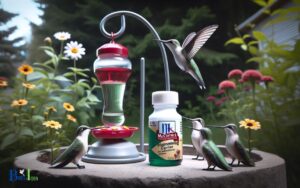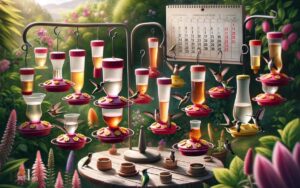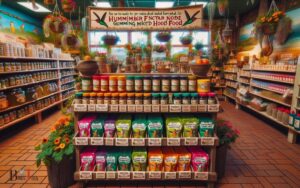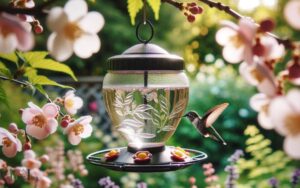When Should I Put Out a Hummingbird Feeder? Find Out!
The ideal time to put out a hummingbird feeder is in early spring, just before the first migrants arrive.
Specifically, you should set up your feeder about two weeks before their expected arrival in your region, which can vary but generally falls between late February and early May.
Hummingbird migration patterns largely dictate when you should hang feeders. These birds typically start moving northward to their breeding grounds as the weather warms up, following spring blooms that provide natural nectar sources.
To determine the best timing for your area, you can:
For example, if you live in the southern U.S., hummingbirds may arrive as early as late February, while in northern regions, they may not appear until May.
Prepare for the aerial ballet of hummingbirds by placing feeders promptly, ensuring these tiny jewels have ample sustenance.
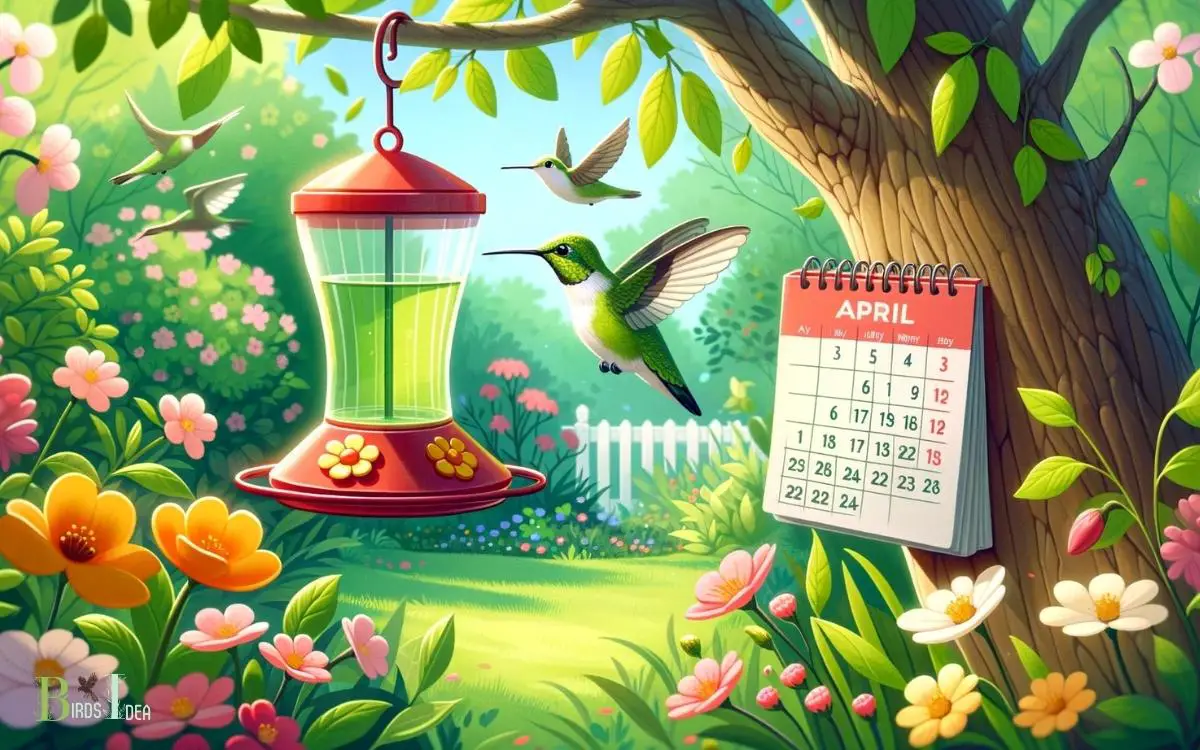
Key Takeaway
Spring: The Perfect Season
Spring is the optimal season for placing a hummingbird feeder. As nature awakens from the dormancy of winter, these delightful creatures emerge in search of nectar.
By strategically situating feeders in your yard or garden during this time, you provide a vital food source for hummingbirds as they begin their nesting and breeding activities.
The availability of nectar in early spring ensures that these tiny birds have the energy they need for their long migrations and the demanding task of raising their young.
Additionally, placing feeders in the spring allows you to attract hummingbirds to your outdoor space early in the season, providing you with the opportunity to observe and appreciate their beauty and grace.
Therefore, by putting out a hummingbird feeder in the spring, you not only serve these incredible birds but also enrich your own experience with nature.
Before Migration Begins
Before migration begins, it’s important to consider the timing for feeder placement in order to attract migrating hummingbirds.
Understanding the patterns of hummingbird migration and when they typically pass through your area can help you prepare your feeder in advance.
By strategically setting up your feeder before migration begins, you can create a welcoming environment for these fascinating birds as they make their journey.
Timing for Feeder Placement
Feeder placement for hummingbirds should occur well in advance of the start of migration. This ensures that the birds have established the feeder as a reliable food source before beginning their journey.
To effectively time the placement of a hummingbird feeder before migration begins, consider the following:
- Early Preparation: Aim to position the feeder in your garden or yard at least two weeks before the expected arrival of the hummingbirds in your area.
- Consistent Availability: Ensure that the feeder is consistently filled with fresh nectar to encourage the birds to return and establish a feeding routine.
- Strategic Placement: Position the feeder in a visible and accessible location, such as near flowers or shrubs that hummingbirds are naturally attracted to.
By following these guidelines, you can help ensure that the hummingbirds find and utilize the feeder before they commence their migration, ultimately supporting their well-being.
To attract migrating hummingbirds…
Attracting Migrating Hummingbirds
To attract migrating hummingbirds before their migration begins, it is essential to strategically position a consistently filled feeder in the garden or yard at least two weeks prior to their expected arrival.
This will provide the hummingbirds with a reliable food source as they pass through on their journey.
Additionally, planting nectar-producing flowers and providing a water source, such as a shallow birdbath, can further attract these beautiful birds.
| Flower Type | Nectar Color |
|---|---|
| Bee Balm | Red, Pink, Purple |
| Salvia | Red, Orange, Pink |
| Trumpet Vine | Orange, Red |
| Coral Honeysuckle | Orange, Red |
When Flowers Bloom
During the spring months, when flowers begin to bloom, is the ideal time to put out a hummingbird feeder to attract these beautiful and delicate birds to your garden.
Hummingbirds are attracted to nectar-producing flowers, and by strategically placing feeders near blooming flowers, you can create an irresistible oasis for these tiny creatures.
To maximize the appeal of your feeder during this time, consider the following:
- Choose the Right Flowers: Plant a variety of nectar-rich flowers such as bee balm, salvia, and trumpet vine to provide natural food sources for hummingbirds.
- Feeder Placement: Position feeders near blooming flowers to create a visually appealing and convenient feeding area for hummingbirds.
- Regular Maintenance: Keep the feeder clean and filled with fresh nectar to ensure a healthy and inviting environment for visiting hummingbirds.
During Mating Season
During mating season, putting out a hummingbird feeder can attract potential mates and support breeding behavior.
By providing a reliable food source, you can help female hummingbirds meet their increased energy needs for egg production and care.
Additionally, the feeder can serve as a beacon for males looking to establish territories and attract females.
Attracting Potential Mates
During mating season, it is crucial to strategically place your hummingbird feeder to attract potential mates.
To attract potential mates, consider the following tips:
- Placement: Hang the feeder in a visible and open area, preferably near a garden or flowering plants, to catch the attention of passing hummingbirds.
- Cleanliness: Ensure the feeder is kept clean and fresh with a regular supply of nectar. Hummingbirds are attracted to clean, well-maintained feeders.
- Colorful and Red Nectar: Use a feeder with bright, eye-catching colors such as red or orange, as these colors attract hummingbirds. Additionally, use nectar that is specifically colored red, as it mimics the natural nectar found in flowers and is more likely to attract potential mates.
Supporting Breeding Behavior
To support breeding behavior during mating season, it is essential to continue providing a clean and well-maintained feeder with brightly colored nectar to attract potential mates to your garden.
Additionally, consider placing multiple feeders in various locations to prevent territorial disputes and allow more opportunities for mating rituals.
During this crucial time, it is important to monitor the feeders closely, ensuring that they are always filled with fresh nectar and kept clean to prevent the spread of diseases that could be harmful to the hummingbirds.
Providing a safe and welcoming environment, with ample food and suitable perches, will encourage hummingbirds to choose your garden as a place to nest and raise their young.
By consistently meeting their nutritional needs and creating a comfortable habitat, you can actively support the breeding behavior of these delightful birds.
Early Morning Feedings
Beginning the day with early morning feedings can provide essential sustenance for the energetic hummingbirds visiting your feeder.
This practice ensures that the birds have the energy they need to start their day and can also help attract them to your feeder consistently.
To make the most of early morning feedings for hummingbirds, consider the following:
- Fresh Nectar: Replace the nectar in your feeder every morning to provide the birds with a fresh and clean food source.
- Strategic Placement: Position your feeder in a location that receives the morning sun, as this can help warm the nectar and make it more appealing to the hummingbirds.
- Regular Monitoring: Check the feeder early in the morning to ensure that it is clean and filled with fresh nectar, allowing the hummingbirds to rely on it for their first meal of the day.
Late Summer and Early Fall
As late summer transitions into early fall, consider maintaining a consistent food source for hummingbirds by keeping your feeder filled with fresh nectar.
During this time, hummingbirds are preparing for their long migration journey or gearing up for the colder months, making it crucial to provide them with the energy they need.
To ensure that you are meeting their needs, here is a table outlining the key considerations for feeding hummingbirds in late summer and early fall:
| Consideration | Action |
|---|---|
| Nectar Freshness | Replace nectar every 2-3 days to prevent spoilage |
| Feeder Placement | Keep feeders shaded to prevent nectar fermentation |
| Feeder Maintenance | Clean feeders weekly to prevent mold and bacteria |
| Planting Late Bloomers | Include late blooming flowers in your garden |
Before the First Frost
As the season progresses, maintaining a consistent food source for hummingbirds becomes increasingly important, especially before the first frost.
Hummingbirds need to stock up on nectar to fuel their long migration south, so it’s crucial to provide them with a reliable food source before the colder temperatures set in.
Here are some key considerations for putting out a hummingbird feeder before the first frost:
- Monitoring Weather Patterns: Keep an eye on weather forecasts to anticipate the arrival of the first frost in your area.
- Regular Feeder Maintenance: Ensure that the feeder is clean and filled with fresh nectar to support the hummingbirds as they prepare for their journey.
- Strategic Placement: Position the feeder in a sheltered area to minimize exposure to harsh weather conditions and provide a safe haven for the hummingbirds.
What Is the Best Time to Put Out a Hummingbird Feeder?
The best time to put out a hummingbird feeder depends on your location and climate. Generally, it is recommended to hang the feeder when temperatures consistently reach above 50 degrees Fahrenheit. Understanding how hummingbird feeders work is crucial, as these small birds rely on the nectar provided in the feeder to fuel their high-energy lifestyle.
When Do I Feed Hummingbirds?
Feeding hummingbirds can be a rewarding experience, and it’s important to provide them with a consistent and appropriate food source.
Here are some general guidelines on when and how to feed hummingbirds:
Timing
Hummingbirds feed throughout the day, primarily during daylight hours. The best times to put out hummingbird feeders are early in the morning and late in the afternoon.
Seasons
In most regions, hummingbirds migrate during the spring and fall. Make sure to put out feeders a week or two before you expect the first hummingbirds to arrive in the spring and keep them up until a week or two after you’ve seen the last ones in the fall.
Consistency
Hummingbirds have high metabolisms and need a consistent source of food. If you start feeding them, it’s essential to maintain the feeding schedule so they can rely on your feeder as a reliable food source.
Weather
During hot weather, hummingbirds may need more frequent feeding because the nectar in the feeder can spoil quickly.
In colder weather, you might need to change the nectar less frequently, but still, keep an eye on it to prevent spoilage.
Monitor Feeder Activity
Keep an eye on the activity around your feeder. If you notice a decline in visits, it could be due to the nectar going bad or competition from other feeders or natural food sources. Clean and refill the feeder as needed.
Cleanliness
Regularly clean your hummingbird feeders. The nectar can ferment and develop harmful mold, which can be detrimental to the hummingbirds’ health.
Clean the feeders with hot water and a small brush every few days, and refill them with fresh nectar.
Nectar Solution
The typical nectar solution for hummingbirds is a mixture of four parts water to one part white granulated sugar.
Boil the water to help dissolve the sugar, then let it cool before filling the feeder. Do not use honey, artificial sweeteners, or red food coloring, as they can be harmful to the hummingbirds.
By following these guidelines, you can attract and provide a reliable food source for hummingbirds while ensuring their health and well-being.
Conclusion
Placing a hummingbird feeder at the appropriate times, such as in spring before migration begins, when flowers bloom, during mating season, and early morning feedings, can attract these beautiful creatures to your garden.
Additionally, late summer and early fall are also ideal times to put out a feeder, before the first frost.
By timing the placement of the feeder strategically, you can enjoy the presence of hummingbirds and contribute to their well-being. Timing is everything, like a well-tuned symphony.

